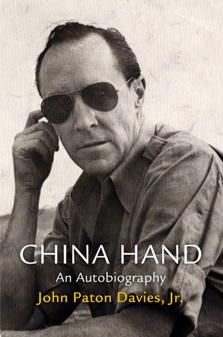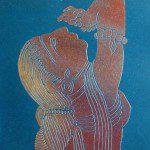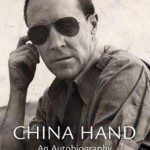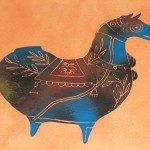‘China Hand’ Davies Could Read the Tea Leaves
By • June 18, 2012 0 1817

When it comes to international affairs, there’s always a lot of talk about American Exceptionalism in political circles and not so much about exceptional Americans.
In the cultural and art world, you hardly ever hear the phrase.
You would have with John Paton Davies, Jr., prescient and courageous American diplomat and later in life, an artist and always husband, father, grandfather.
All of those qualities come to the fore in Davies’s posthumously published autobiography, “China Hand.” (Davies died in 1999 at the age of 91.) It coincided with a remarkable exhibition called “A Singular View: The Art and Words of John Paton Davies, Jr.,” which closed recently after a stay at the Mansion at Strathmore.
It was an exhibition that shimmers with a singular life and a history of the times and interests of Davies, a veteran American diplomat whose advice and reports about China during World War II and immediately after eventually cost him his job, an extreme case of the consequences of daring to speak truth to power during the McCarthy era.
The exhibition, the autobiography and the work and life all showcased qualities deserving of attention—for historians, for lovers of unique art, and admirers of singular people.
Davies was that rarest of men—a true American original, whose expertise, curiosity, gifts and knowledge functioned at a high level throughout his life. He lived the life of a high-ranking and highly-regarded foreign service professional among many of his peers—George Kennan was a friend. In the 1950s, having lost his career he began another, moving to Lima, Peru, to open a furniture store with his wife and family. He excelled in both worlds, but he was much more than that—good father and husband, exceptional writer and student of history and art.
All of this was very much in evidence in the art he created while in Peru, in the memoir, in the life. Many of the prints—he based them on pre-Columbian art—also bear a striking echo of Chinese art in their dramatic simplicity. Both the Latin American and Chinese-influenced prints seemed at once ancient and modern, something he saw clearly in his study of the art. “While the record of these ancient art forms reflects the flight of centuries, it is apparent in that in their strength, their vitality, often in their humor, they are modern as tomorrow, as rich and visited to the decorative quality as a millennium of yesterdays,” he wrote.
That’s a fact, and that’s poetry, also. The exhibition includes photographs from his life—of Davies and his wife Patricia Grady Davies in their studio in Lima, among others. The works, mostly monoprints comprise a kind of journey, and are not devoid of a winsome quality as well as a powerful simplicity. Most of the works in the exhibition had been seen publically only once before in 1961 at the Little Gallery in Birmingham, Mich.
Davies was the son of American missionaries in China and was born there. He entered the then new professional foreign service in the 1930s and served in China beginning, off and on, in 1933. He was on the staff of the legendary General Joseph “Vinegar Joe” Stilwell in World War II. In China, he saw the forces of both Communist leader Mao Tse Tung and Nationalist leader Chiang Kai-shek up close. Davies argued that Chiang was corrupt and would not prevail in the battle against the Communists and suggested that the U.S. establish ties with Mao. This kind of assessment—while accurate and pragmatic—did not sit well with the powers-that-be in Washington, embroiled in the McCarthy disloyalty hunts of the time. Davies and other China hands were caught up in the furor, characterized as men who had “lost” China. He had numerous security investigations against him, all unfounded and with no proof of disloyalty ever found. Instead, the staunch anti-communist Secretary of State John Foster Dulles fired him for lapses in “judgment, discretion and reliability,” after Davies had refused to resign. In 1969, after years of battling, Davies had his security clearance restored.
He and his wife—a writer and partner in her husband’s business in Peru—moved the family to Peru, site of his last diplomatic posting. They were married for 57 years and raised a family of seven, six daughters and a son, among them Patricia “Tiki” Davies, who was for years the communications director at the Kennedy Center.
In pictures, Davies, sometimes wearing sun glasses as on the cover of his autobiography, looks lean, intelligent and thoughtful. Like so many things, pictures don’t always tell the whole story. They certainly don’t encompass the life, work, art, loves, family and friendships, of the exceptional American life lived by John Paton Davies, Jr. In “China Hand,” you find a man with a keen gift for to-the-point story-telling. The book encompasses his foreign service life and is full of insights about the men and women he encountered, among them Stilwell, Kennan, Mao Tse Tung, and Chiang Kai Shek.
(“China Hand” is published by the University of Pennsylvania Press, part of the Haney Foundation Series.)
- Book cover of “China Hand.” | “China Hand” is published by the University of Pen




